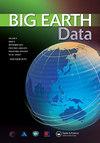Global Reference Grids for Big Earth Data
IF 3.8
3区 地球科学
Q1 COMPUTER SCIENCE, INFORMATION SYSTEMS
引用次数: 4
Abstract
The emerging field of Discrete Global Grid Systems (DGGS) provides a way to organise, store and analyse spatio-temporal data at multiple resolutions and scales (from near global scales down to microns). DGGS partition the entire planet into a discrete hierarchy of global tessellations of progressively finer resolution zones (or cells). Data integration, decomposition and aggregation are optimised by assigning a unique spatio-temporal identifier to each zone. These identifiers are encodings of both the zone’s location and its resolution. As a result, complex multi-dimensional, multi-resolution spatio-temporal operations are simplified into sets of 1D array and filter operations. DGGS are therefore particularly suited for efficient multi-source data processing, storage, discovery, transmis-sion, visualisation, computation, analysis, and modelling. DGGS are supported by both the Open Geospatial Consortium (OGC) and the International Organization for Standardization (ISO) TC211 standards (OGC Abstract Specification – Topic 21 1 , ISO 19170-1 2 ). These published specifications support 2D equal-area DGGS of the Earth’s surface. Current work led through both OGC and ISO/TC-211 is drafting standards to specify 3D (3D & equi-volume) 3 , 4D (spatio-temporal) 4 and axis-aligned 5 DGGS, as well as OGC API DGGS 6 , 7 interface encodings for DGGS infrastructures. The continued effort to develop international standards for DGGS will support the implementation of standardised interoper-able Global Reference Grid Infrastructures that can support efficient and scalable integration of Big Earth Data across multiple organisations around the world. we global大地球数据的全球参考网格
离散全球网格系统(DGGS)这一新兴领域提供了一种以多种分辨率和尺度(从近全球尺度到微米尺度)组织、存储和分析时空数据的方法。DGGS将整个星球划分为一个离散的层次结构,逐步细分为更精细的分辨率区域(或细胞)。通过为每个区域分配唯一的时空标识符,优化数据集成、分解和聚合。这些标识符是区域位置及其分辨率的编码。将复杂的多维、多分辨率时空运算简化为一组一维阵列和滤波运算。因此,DGGS特别适合于高效的多源数据处理、存储、发现、传输、可视化、计算、分析和建模。DGGS受到开放地理空间联盟(OGC)和国际标准化组织(ISO) TC211标准(OGC抽象规范-主题211,ISO 19170- 12)的支持。这些公布的规范支持地球表面的二维等面积DGGS。OGC和ISO/TC-211目前的工作是起草标准,以指定3D (3D和等体积)3,4d(时空)4和轴对齐5 DGGS,以及OGC API DGGS 6,7接口编码的DGGS基础设施。为DGGS制定国际标准的持续努力将支持可互操作的标准化全球参考网格基础设施的实施,这些基础设施可以支持全球多个组织之间高效和可扩展的大地球数据集成。我们的全球
本文章由计算机程序翻译,如有差异,请以英文原文为准。
求助全文
约1分钟内获得全文
求助全文
来源期刊

Big Earth Data
Earth and Planetary Sciences-Computers in Earth Sciences
CiteScore
7.40
自引率
10.00%
发文量
60
审稿时长
10 weeks
 求助内容:
求助内容: 应助结果提醒方式:
应助结果提醒方式:


